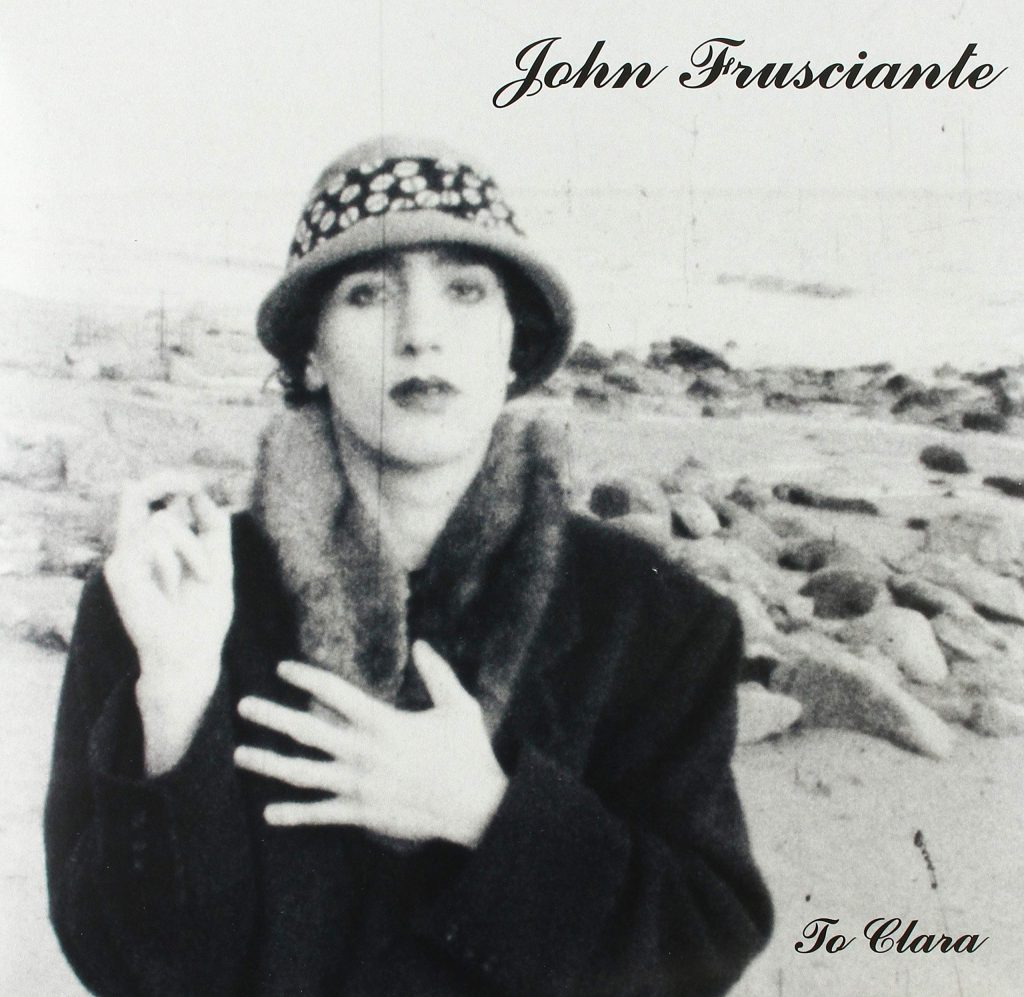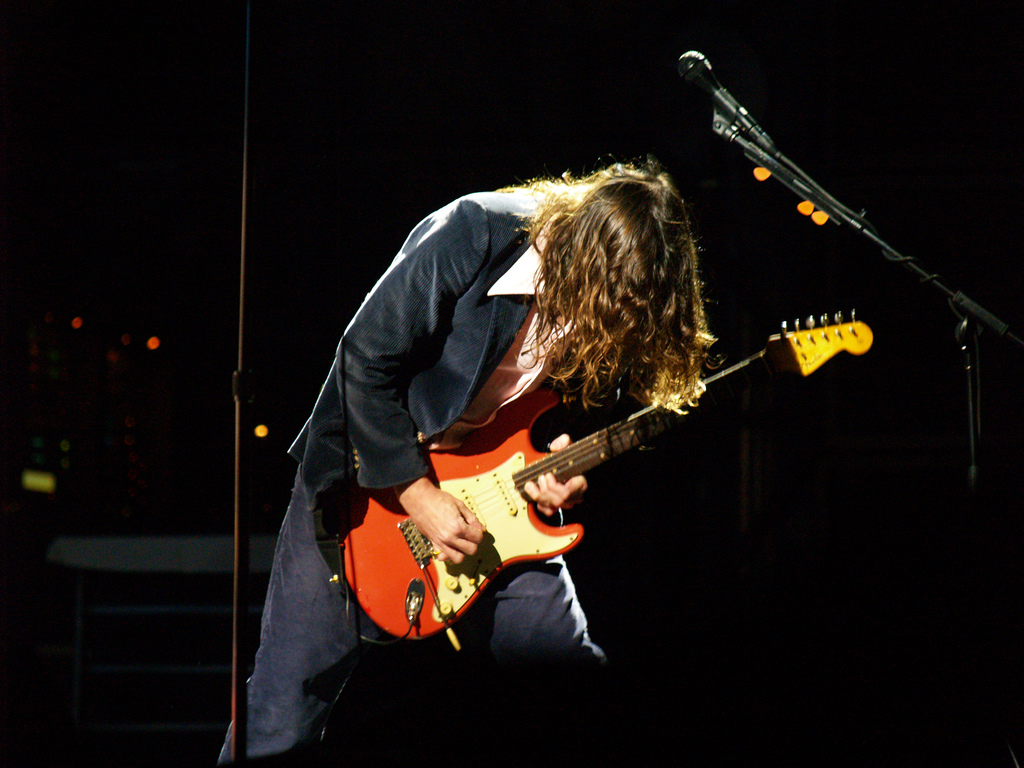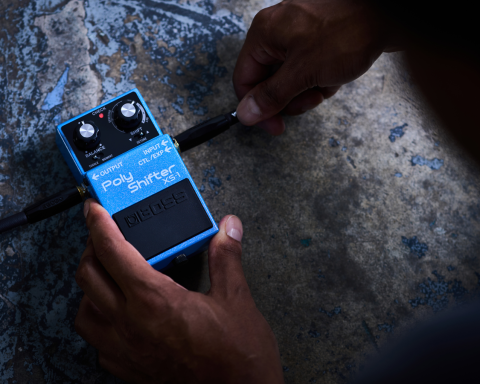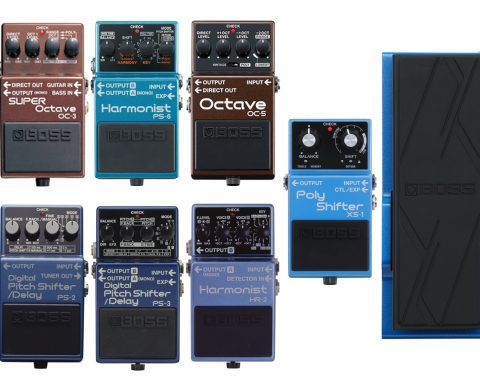Guitar tech Dave Lee has built an exceptional career alongside some of rock’s most iconic artists. He is best known for his long-standing role with John Frusciante of the Red Hot Chili Peppers, a gig that cemented his reputation in the music industry. Lee currently lends his talents to Adam Levine of Maroon 5, who once quipped, “If he can handle John Frusciante, he can handle me.” When he’s not on the road, this top-tier tech continues to hone his skills building instruments and restoring motor vehicles. BOSS called Lee at his California home, where he shared rare insights into a remarkable past.
The Road to Roadie
Like many a “roadie,” Lee says he began his journey as a musician. In the 1980s, he played bass in an LA hair metal band called Hostage, but when it didn’t work out, he sold his gear and turned to construction. A serious injury in 1988 ended that path, whereupon a friend in the music business suggested Lee give tech work a try.
His first gig was with Danish shock rocker King Diamond, whose satanic imagery initially unsettled the rookie roadie. Nonetheless, he found his unlikely employer surprisingly down-to-earth, and they clicked immediately. From there, Lee’s tech career gathered momentum. He joined Faith No More’s crew as The Real Thing began gaining traction before moving on to work with Faster Pussycat. Over the years, he added notable names like Korn, Ozzy Osbourne, and Suicidal Tendencies to his résumé.
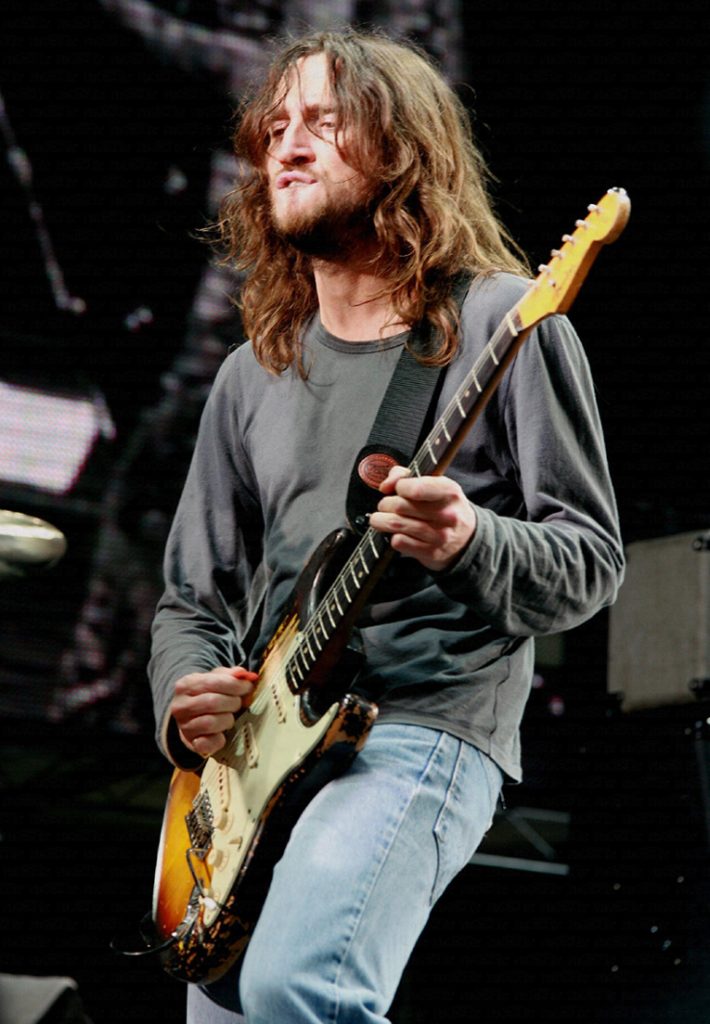
However, Lee’s work with the Red Hot Chili Peppers solidified his status as a world-class guitar tech. From 1995, he assisted Dave Navarro, whose tenure as guitarist began the year following Frusciante’s harrowing first departure in 1992. Rising phoenix-like from the ashes of addiction, Frusciante rejoined the band in 1998. Renewed and reunited, the quintessential Chili Peppers lineup then proceeded to sign off the ‘90s with their most commercially successful album to date, Californication. Throughout this monumental rebirth, Lee remained by Frusciante’s side, playing a pivotal role as relentless touring propelled the Red Hot Chili Peppers to unprecedented heights of global rock stardom.
Then, having dominated the alt-rock soundtrack of the ‘00s with albums like By the Way and Stadium Arcadium, Frusciante decided to quit again at the end of the decade. And when he did, so too did Lee. It was the end of an era
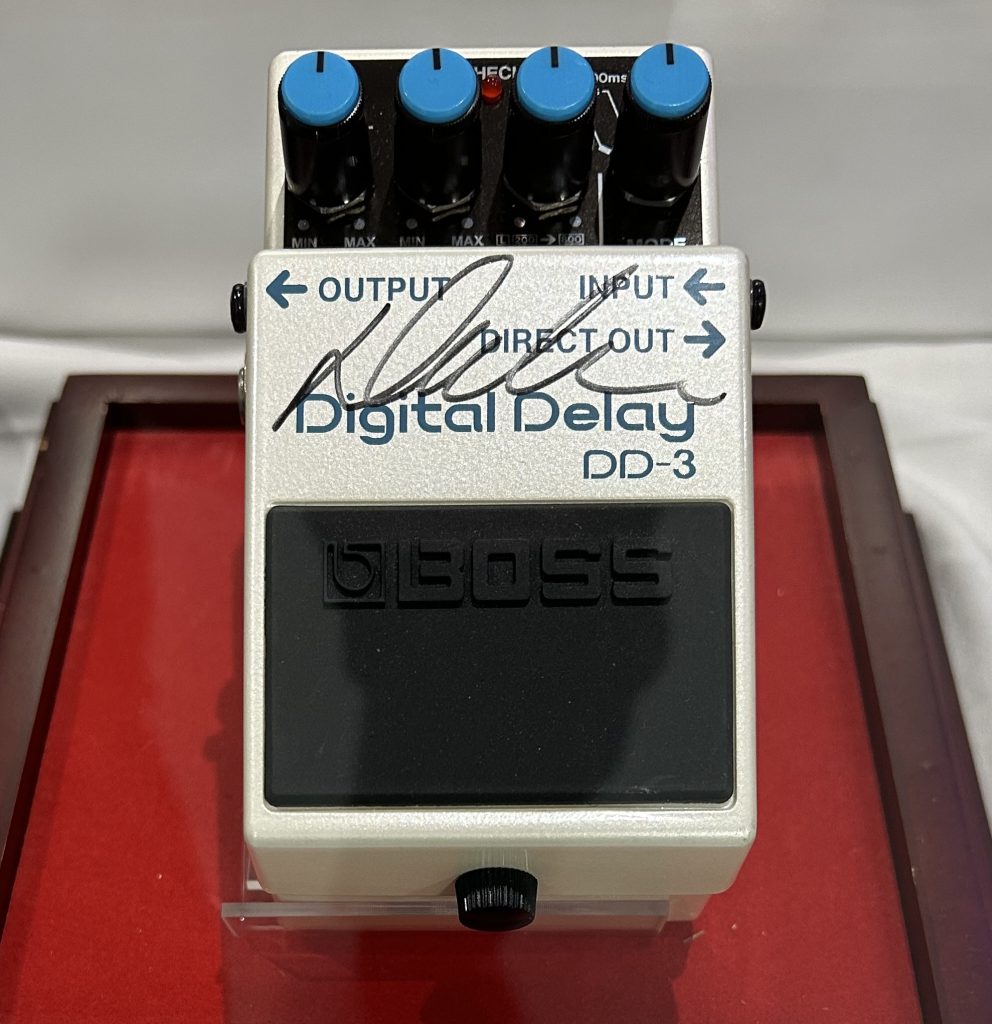
Hot Takes from a Hot Minute
How did you become the Red Hot Chili Peppers’ guitar tech?
I was in the right place at the right time. I had just wrapped up a tour with Suicidal Tendencies when I got the call saying Dave Navarro needed a guitar tech. They had just released the One Hot Minute album, and Dave needed somebody to fill in for a couple of weeks because his regular guy was off doing something else. One day, the band was sitting there having a meeting about the upcoming tour when Dave realized his tech wasn’t going to be able to make it. That’s when he walked over to me and asked, “Do you want to do the tour?” That moment completely changed my life.
Did you enjoy working with Dave Navarro?
I had so much fun working with Dave. It was just laughs all the way. He and Chad Smith are, let’s say, “mischievous.” It was constant high jinx with those guys. It sounds crazy, but even when Dave fell off the wagon, he still managed to be fun. On the Jane’s Addiction reunion tour in 1997, he wasn’t doing so great, and I remember sitting down and saying to him, “I’m genuinely worried about you.” It was a scary time, but he would always say the funniest stuff. I’d be like, “How can you still be funny? You’ve been up for three days!”
What pedals were on Dave Navarro’s board when he played with the Chili Peppers?
Apart from his wah, I don’t remember Dave using anything apart from BOSS pedals. And it was all new stuff. He wasn’t one of those guys who needed to have a vintage pedal. I remember he needed another chorus pedal one day, so we just went to Guitar Center and bought his usual BOSS model, the CH-1 Super Chorus. He also used the DD-3 Digital Delay, DS-2 Turbo Distortion, PH-2 Super Phaser, OC-2 Octave, and NS-2 Noise Suppressor.
"The three most important things were John’s hands, the guitar pickups, and the BOSS CE-1."
Dave Lee
Loud, Clean, and Punchy
John Frusciante is a fan of BOSS pedals, too.
The BOSS CE-1 Chorus Ensemble is crucial to John’s sound. We used it to split the guitar signal to the two Marshall heads. That was the way we went stereo into the Marshall Major and Silver Jubilee. In John’s mind, that’s what the CE-1 did, aside from being a chorus pedal with a nice preamp. John also used a third stack with no pedals, which was just a Silver Jubilee with a Les Paul plugged straight into it. He used that for natural tube distortion on two songs: “Readymade” and “Fortune Faded.”
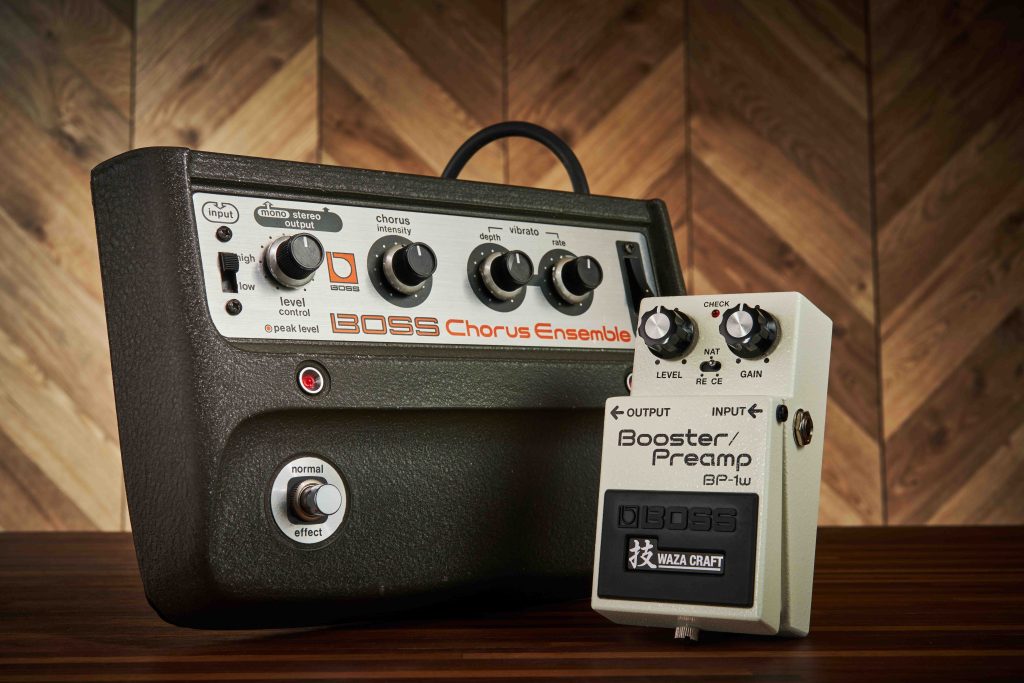

How important was the BOSS CE-1 Chorus Ensemble preamp?
The three most important things were John’s hands, the guitar pickups, and the BOSS CE-1. The preamp Level Control on the CE-1 was a vital part of it. We would dial in the gain using that to get to the point where it just starts to distort when you play hard. That one knob was so much more important than the rest of his pedalboard. I can’t even see him doing a show without the CE-1.
John’s basic sound via the BOSS CE-1 was super loud, clean, and punchy. He’d take that and use other pedals for distortion or whatever. To ensure his rig was set up and sounding correct, I’d play a couple of Frusciante licks and listen to how it resonated, using that clean, punchy sound that distorts just a little bit when you hit the strings hard.
What was your favorite set moment featuring the CE-1 chorus sound?
When John played “Soul to Squeeze” and hit the CE-1 chorus at the beginning: Oh my god! It still gives me goosebumps thinking about it now. We didn’t have in-ears at the time, so I would listen to them playing in these big arenas with that gorgeous chorus guitar tone filling the air.
"I would listen to them playing in these big arenas with that gorgeous chorus guitar tone filling the air."
Dave Lee
The BOSS DS-2 Turbo Distortion is also a pedalboard mainstay of John Frusciante’s.
Yeah, for sure. That’s one of his favorites. We even had two of those on the board at one time. The BOSS CE-1 Chorus Ensemble and DS-2 Turbo Distortion pedals are totally crucial. But he also used a ton of different pedals at one time or another. John and Vincent Gallo would go shopping, and he would show up with boxes of stuff. We’d plug in a new pedal and see what happened, but it was funny because he’d plug into it for two seconds and go, “Nope. Next!” He would make his mind up instantly. Sometimes, when we were on tour, he would buy something, show up with it, and ask me, “Can you put this on the board for tonight?” I’d be like, “Yeah, sure, if it works.”

Do you find the same rig can sound completely different in someone else’s hands?
For sure. A perfect example of that would be the first time I worked with John after Dave Navarro had left. I went down to the studio, and John’s rig was already set up. But when I plugged into it, it didn’t sound like him at all. I said, “Something’s not right. It doesn’t sound right.”
When John showed up, he was very quiet. I think he was a little shell-shocked, and very few words were spoken. But when he plugged in, it all made sense. Before that moment, I didn’t really believe that great guitar tone was, as they say, “in the hands.” But as soon as John plugged in and started playing, I said, “I get it now.”
"The BOSS CE-1 Chorus Ensemble and DS-2 Turbo Distortion pedals are totally crucial."
Dave Lee
Transition Time
How was the transition between Dave Navarro and John Frusciante?
I remember the day Dave left the Chili Peppers back in 1998. They were in rehearsals, getting ready to go to a show in Alaska. Dave still wasn’t taking care of himself at this point, and the rehearsal was a disaster. He came up to me and asked, “Do you think you could give me a ride home? I don’t think I should be driving.” So, I gave him a ride home, and I could tell the writing was on the wall, that things weren’t going well. Anthony and Chad showed up at Dave’s house when I was still there with him. That’s when they decided it wasn’t working out.
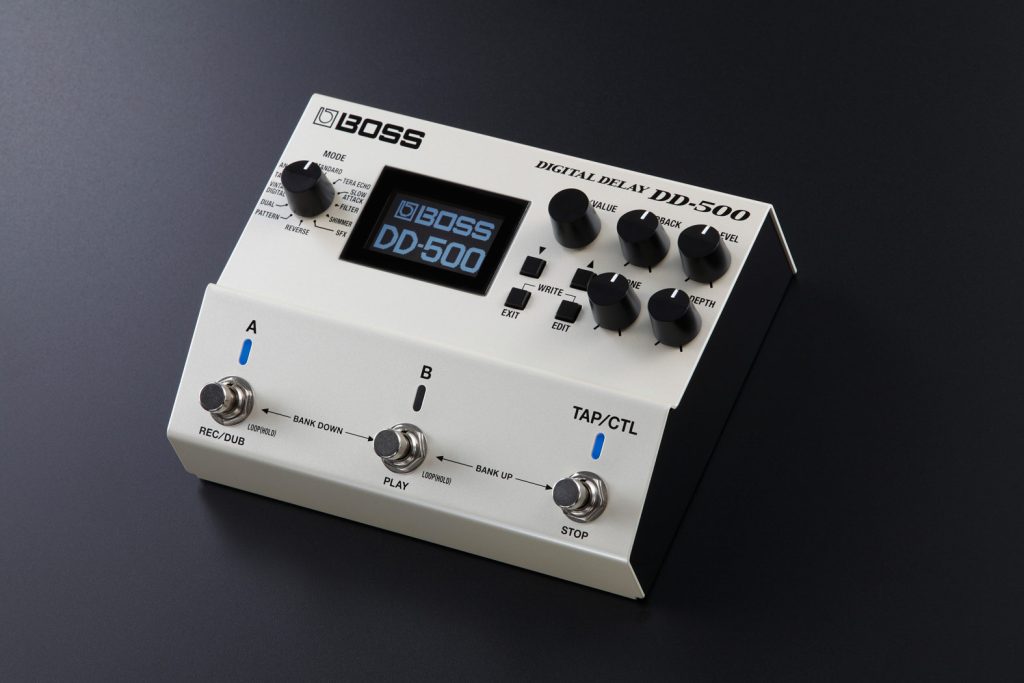
I went back to the studio, and Flea was still there. When Chad and Anthony came back, Flea said, “John says he wouldn’t be opposed to coming back.” I remember Anthony kind of laughed and goes, “Wouldn’t be opposed?” I looked at Flea and asked, “Is John okay? The last I heard, he was in terrible shape,” and he said, “Well, he thinks he’s okay!” This all happened on the same day.
It’s weird how things can change in an instant. The moment Dave Navarro walked up to me and asked if I wanted to do the Chili Peppers tour changed my life. The next life-changing moment was when John Frusciante came back. That took everything up to a whole other level. When John returned, we did a handful of shows to see how it would go, and it all went great. After that, they went into the studio and recorded Californication.
"The moment Dave Navarro walked up to me and asked if I wanted to do the Chili Peppers tour changed my life. The next life-changing moment was when John Frusciante came back."
Dave Lee
A Steamroller of Success
What did you do while they were recording Californication?
I went to work for Ozzy Osbourne and Korn, mostly.
What do you recall about John’s Californication-era pedalboard?
It was a relatively small pedalboard for John to begin with. There was an original WH10 wah pedal we’d borrowed from SIR. John liked it so much that we took it with us when we left the studio. He wouldn’t use anything else. At the time, I didn’t realize how fragile they were. They kept breaking because they’re made of plastic. I thought I could just keep buying more, but they became increasingly difficult to find.

Eddie Van Halen’s tech, Matt Bruck, was a genius at locating hard-to-find gear. He helped us get John a WH10 and a Marshall Major. I was at John’s house when Matt called me and said, “I’ve found you a WH10. I’m at Eddie’s house. You can come on over and pick it up if you like.” So, I drive over to the Eddie Van Halen residence, and when I pull up outside, Ed is standing there with the WH10 wah in his hand, just kind of looking at it. He goes, “Why does John Frusciante want a piece of crap like this?”
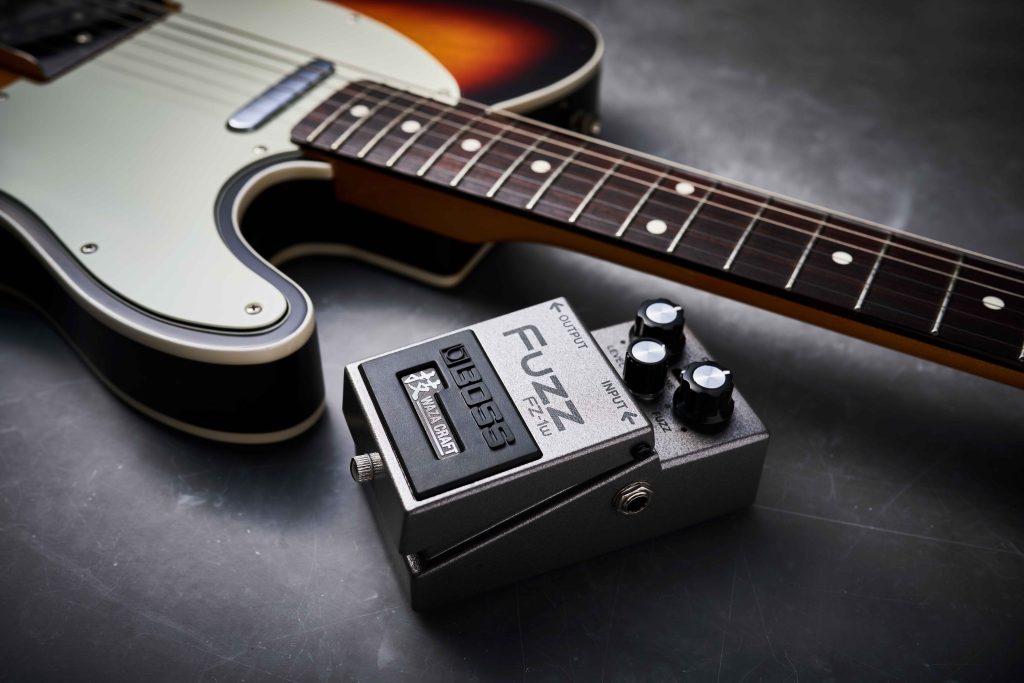
I laughed and said, “Yep. You’re right. It is made of plastic, and they break all the time. That’s why we need this one. We only have one left.” He looked at me very seriously and said, “Listen, man. You need to tell John this is the only one left. Because when I’m using a pedal, and I think it’s the only one I’ve got, I’m a lot more careful with it.” That was some good guitar tech advice from Eddie Van Halen. John thought that was hilarious.
John’s Californication-era pedalboard also included the BOSS FZ-3 Fuzz.
Yeah, he used the FZ-3 Fuzz for a while. He’s used a number of different fuzz pedals over the years. At one point, he would go back and forth between the FZ-3 and the Big Muff. He also used a Foxx Fuzz & Wa with a funky red velvet finish for a short time.
When you started working with John Frusciante in 1998, did you hit it off immediately?
I have to be honest: I wasn’t really enjoying it very much to begin with. I had such a great time with Dave Navarro, but when John Frusciante returned, he didn’t talk to me very much. I mean, he barely said anything. I almost quit because I thought John didn’t like me. He would hardly talk to me, so I had to figure stuff out without any input. Several months in, he still wasn’t saying much to me. One day, we were doing a show, and he looked over like he wanted to tell me something. So, I went over, and he said, “I need more bass in the sidefill.” I walked back, and our production manager, Chris Kansy, goes, “He talked to you! What did he say?” Jokingly, I replied, “He asked me who I am and why am I following him around.”
"John went about as far as it was possible to go and still survive... Ultimately, it was up to him to save his own life."
Dave Lee
Do you think John was still getting over a rough time during that period?
He definitely was. But he went about as far as it was possible to go and still survive. To this day, his mom calls all the people around him “angels.” She feels like we were all part of saving his life. But think about how far she saw her son go. Thankfully, he was able to pull it together. Barely. But he did. And that’s the most important thing. Ultimately, it was up to him to save his own life.
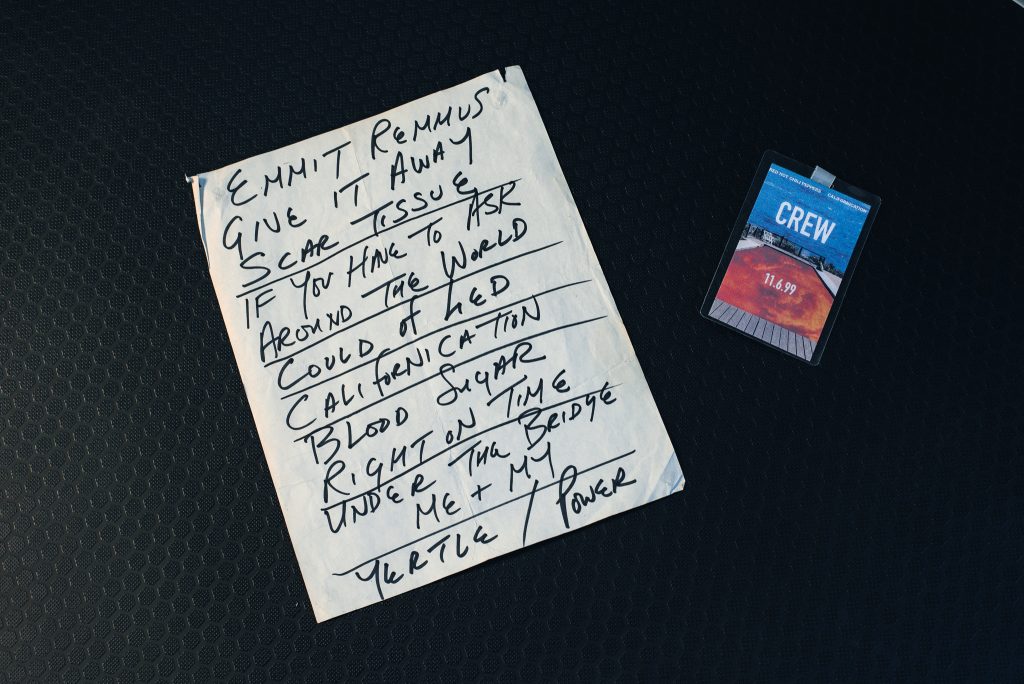
Of Binoculars and Budokan
What was the breakthrough moment between John and yourself?
We were at a soundcheck in Italy. I was staring at something through binoculars, totally in my own world. I didn’t realize the band had finished, and John was waiting to hand me the guitar. I said, “Oh! Sorry about that,” and he goes, “I just want to tell you that you’re doing a great job, and I really appreciate it.” That turned everything around for me instantly.
The next breakthrough was at the Budokan in Tokyo. We were sound-checking when John came up to me and asked what I knew about buying CDs in Japan. I told him I’d found a live bootleg Genesis CD with Peter Gabriel that I’d never heard before, and John said, “That early Genesis with Peter Gabriel is some of my favorite music. I love that stuff.” That’s when we really bonded about something other than work.
This led to John arranging for me to meet my musical hero, the Yes bassist Chris Squire, who was a mutual friend of Vincent Gallo’s. Chris Squire was where my interest in music really started. I saw his name on the guest list at a show in the UK and said to John, “Chris Squire’s name is on the guest list!” He goes, “Damn! That was supposed to be a surprise!”
"John arranged for me to meet my musical hero, the Yes bassist Chris Squire."
Dave Lee
I was packing up after the show when John sent me a text saying, “Come down to the dressing room.” I was thinking, “Oh no, what happened?” But John met me in the hallway outside and said, “Chris Squire is in here having dinner with us. I saved you a seat right next to him.” I was so nervous, but he told me, “Get a plate, put some food on it, and go sit next to Chris Squire. You need to do this. You won’t get another chance.” I couldn’t believe it. It was incredible. Chris and I talked for about an hour about technical stuff—gear he used on different songs. He was super cool.

Departures and Returns
What did you do when John quit the band again in 2009?
Everything shut down when he officially left in 2009, but the writing was already on the wall. I remember John and I were sitting in the dressing room at either the Reading or Leeds Festival in 2007, and he told me he was going to take two years off. He said, “After that, I’ll know if I want to be in the band.” It was a bummer, but I understood: he had to do what he had to do.
Some people find it strange that he quit.
A lot of people don’t understand it. They’re like, “How can you quit the Red Hot Chili Peppers?” For a lot of musicians, being in a band like the Chili Peppers would be the pinnacle. One in a million musicians get that kind of success. The chances are so slim, even for really talented people.
What do you think was the secret to John Frusciante’s success?
It sounds cliched, but it really is accurate: John was true to himself and his art. He refuses to let success, or the hope of success, guide his creative world. That’s the only way I can explain it. When John wrote “Under the Bridge,” for example, he wasn’t trying to make a hit song; he wrote it because that’s what he felt like doing.
"It sounds cliched, but it really is accurate: John was true to himself and his art. He refuses to let success, or the hope of success, guide his creative world."
Dave Lee
Does that have any bearing on why he quit the Red Hot Chili Peppers again in 2009?
They had released Stadium Arcadium to gigantic success, and he appreciated that. But he really does not make any music because he hopes it’ll make him money. And that is absolutely true. I’m a natural skeptic, and when I hear people say things like, “I don’t want to be a musician for fame and fortune,” I think, “That’s bullshit.” But this is a case where I literally witnessed it. For real. The dude walked away from the Chili Peppers after Stadium Arcadium. Now, what does that tell you? One thing’s for sure: he’s not there for the success.
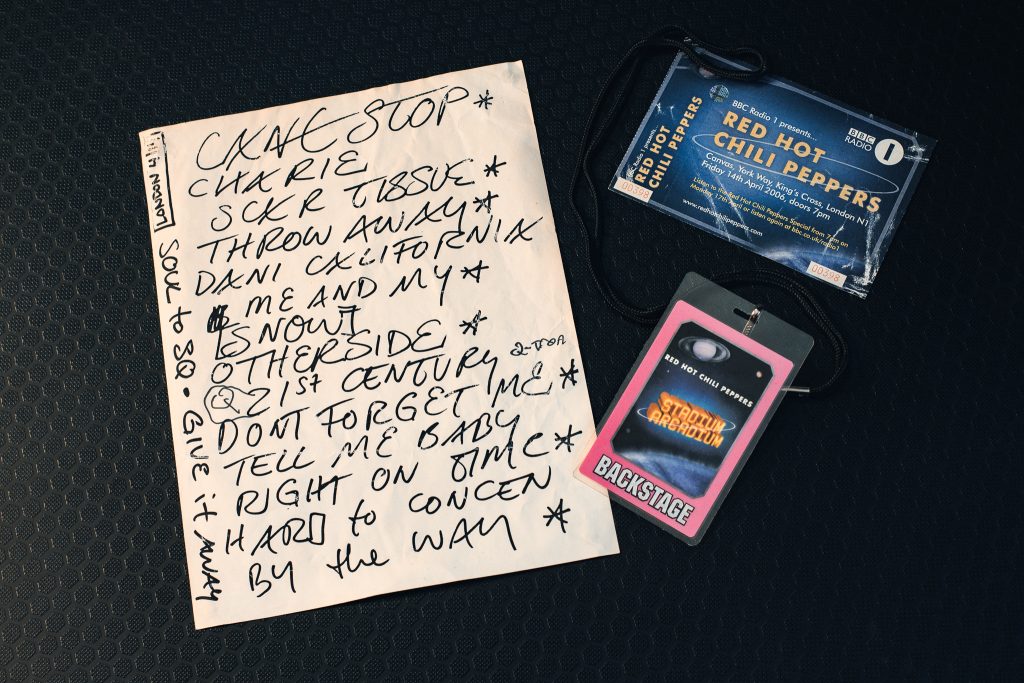
Strats in the Sun
Did John Frusciante get in touch with you before he returned in 2019?
Right before he returned to the Chili Peppers again in 2019, John called me up out of the blue. I was in my garage when the phone rang, and “John Frusciante” appeared on the screen. I hadn’t talked to him in years. I answered, and he said, “Hi Dave. It’s John.” I paused for a second, and he goes, “Frusciante.” It was the craziest thing. He said, “I haven’t played my Strats in years. I’ve been messing around with them lately, and I think they’re broken. They just don’t feel right. I’ve had them on a stand in my living room, and the sun gets on them. I think that might have ruined them.”
So, I asked him, “Do you want me to come over and look at them?” He goes, “Would you do that?” I said, “Yeah, I’ll come by tomorrow,” and he goes, “That’d be great!” So, I went round to John’s the next day and checked out his guitars. They needed to be set up again, but I told him, “I don’t think there’s anything wrong with them.”
"Right before he returned to the Chili Peppers again in 2019, John called me up out of the blue."
Dave Lee
At that point, did you have any inkling he was considering returning to the Chili Peppers again?
That’s the funny thing: It didn’t occur to me that John might be thinking of rejoining the Chili Peppers. There’s a place I go to called Eric’s Guitar Shop, where I’ll take instruments for major repairs or maybe something I’m baffled about. At least, I thought it best to take some of John’s main Chili Peppers Strats to Eric’s for a second opinion: the Sunburst ’62 and ’55, the Olympic White ’64, and the Fiesta Red ’61. I also took the ‘60s Telecaster Custom.
When Eric saw them, he looked at me and goes, “John’s going back to the Chili Peppers.” I said, “No way is he ever going back to the Chili Peppers. I just spent two hours with him, and he’s the happiest I’ve ever seen him.” But Eric goes, “I bet you he is.” I guess he was right!
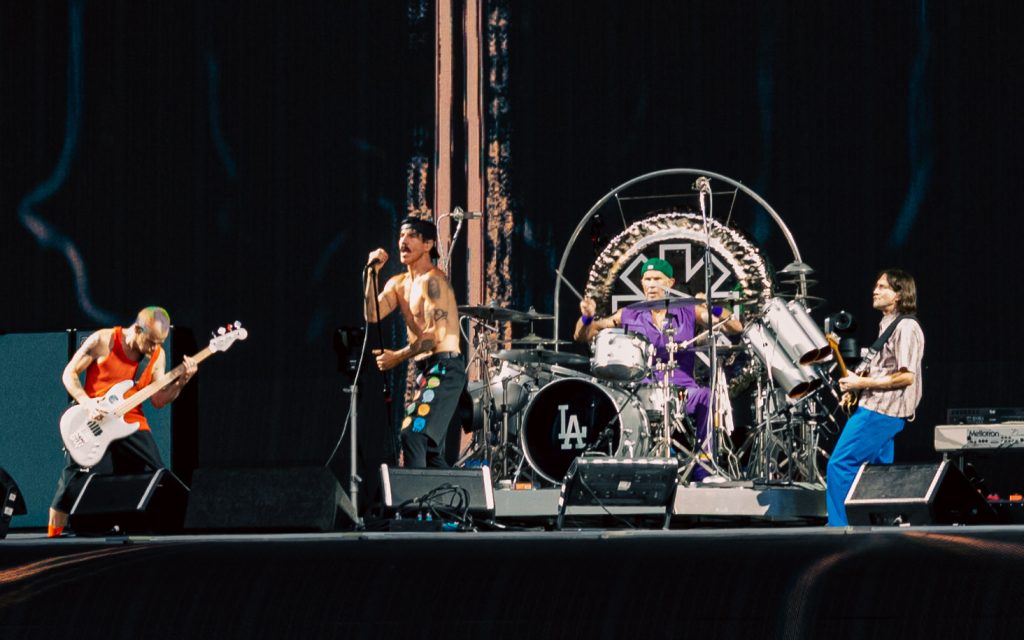
A Life-Changing Connection
It must have been nice to connect with John Frusciante again after so long.
It was great because I got the opportunity to sit down with him and finally thank him for the huge impact he’s had on my life. I can’t even express how important John has been to me. When I became his guitar tech, I didn’t even realize what I was getting into. But it was life-changing. When you’ve worked for a guy like John Frusciante, it immediately puts you at a certain level where you’re either going to sink or swim. Before I worked for John, I don’t think I was much of a guitar tech. It was a huge learning experience. When I left his house that day, I was so happy I got to thank him for everything.
Did John Frusciante ask you to work for him again after he returned to the Chili Peppers in 2019?
I got a text from John. He wrote: “I know that you probably don’t want the job, but I’m just letting you know that it’s available to you if you want it.” Maroon 5 had so much work planned, so I texted him back saying, “John, I’ve committed to a bunch of stuff that I have to do. But I’ll gladly help you in any way I can to get stuff sorted out.” It felt so weird having to turn that down.
"I can’t even express how important John has been to me. When I became his guitar tech, I didn’t even realize what I was getting into. But it was life-changing."
Dave Lee
A Fun Atmosphere
How are you enjoying your current work with Maroon 5?
Adam Levine is a really great guy. I genuinely like him on a personal level. When a fan tells me they love him, I’m quick to say, “I love him more than you do!” And I enjoy the music. It’s a fun atmosphere, and we have a really good time. I got that job because somebody told them, “John Frusciante’s guy is available.” That’s what got me the job. That connection really changed my life. I’m glad I could tell John how much that meant to me and the positive effect my association with him has had on my life.
What are the main differences between Red Hot Chili Peppers and Maroon 5?
Well, for starters, the Maroon 5 gig is far less stressful and far more stable. Technology has made it easier. There’s only one cabinet on stage with those guys: an SVT cab. The rest is digital modeling technology. I see the downsides of using that kind of gear. I mean, sometimes you just want to be pushing air. But the upside is that everything works all the time. And if it doesn’t work, it’s very simple to fix. I mean, the troubleshooting part of the job has virtually gone.
